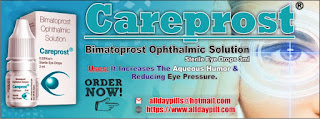Careprost eye drops: Best solution to treat glaucoma and high pressure in the eyes

Glaucoma is a condition that harms your eye's optic nerve. It deteriorates over time. It's frequently connected to the development of pressure factors inside your eye. Glaucoma will in general run in families. You normally don't get it until some other time throughout everyday life. The expanded pressure factor in your eye, called intraocular pressure, can harm your optic nerve, which sends pictures to your brain. If the harm declines, glaucoma can cause perpetual vision misfortune or even complete visual impairment within a couple of years. The vast majority with this condition have no early indications or agony. Visit your eye specialist consistently so they can analyze and treat this condition before you have long-haul vision loss. If you lose vision, it can't be brought back. In any case, bringing down the eye pressure factor can help you keep the sight you have. The vast majority with glaucoma who follow their treatment design and have normal eye tests can keep t...
